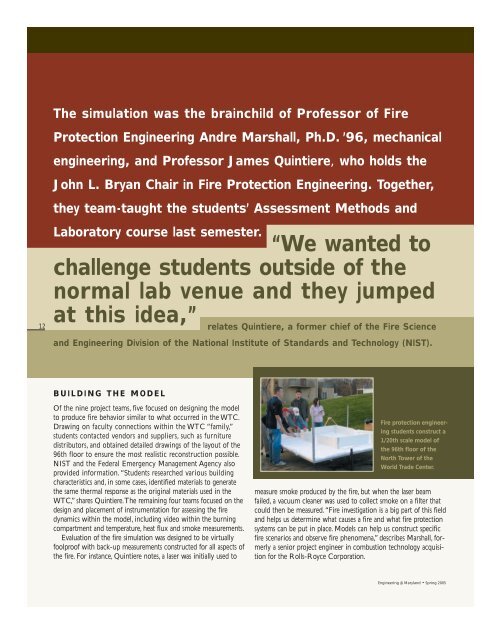Spring 2005 - A. James Clark School of Engineering - University of ...
Spring 2005 - A. James Clark School of Engineering - University of ...
Spring 2005 - A. James Clark School of Engineering - University of ...
You also want an ePaper? Increase the reach of your titles
YUMPU automatically turns print PDFs into web optimized ePapers that Google loves.
12<br />
The simulation was the brainchild <strong>of</strong> Pr<strong>of</strong>essor <strong>of</strong> Fire<br />
Protection <strong>Engineering</strong> Andre Marshall, Ph.D. ’96, mechanical<br />
engineering, and Pr<strong>of</strong>essor <strong>James</strong> Quintiere, who holds the<br />
John L. Bryan Chair in Fire Protection <strong>Engineering</strong>. Together,<br />
they team-taught the students’ Assessment Methods and<br />
Laboratory course last semester.<br />
“We wanted to<br />
challenge students outside <strong>of</strong> the<br />
normal lab venue and they jumped<br />
at this idea,” relates Quintiere, a former chief <strong>of</strong> the Fire Science<br />
and <strong>Engineering</strong> Division <strong>of</strong> the National Institute <strong>of</strong> Standards and Technology (NIST).<br />
BUILDING THE MODEL<br />
Of the nine project teams, five focused on designing the model<br />
to produce fire behavior similar to what occurred in the WTC.<br />
Drawing on faculty connections within the WTC “family,”<br />
students contacted vendors and suppliers, such as furniture<br />
distributors, and obtained detailed drawings <strong>of</strong> the layout <strong>of</strong> the<br />
96th floor to ensure the most realistic reconstruction possible.<br />
NIST and the Federal Emergency Management Agency also<br />
provided information.“Students researched various building<br />
characteristics and, in some cases, identified materials to generate<br />
the same thermal response as the original materials used in the<br />
WTC,” shares Quintiere.The remaining four teams focused on the<br />
design and placement <strong>of</strong> instrumentation for assessing the fire<br />
dynamics within the model, including video within the burning<br />
compartment and temperature, heat flux and smoke measurements.<br />
Evaluation <strong>of</strong> the fire simulation was designed to be virtually<br />
foolpro<strong>of</strong> with back-up measurements constructed for all aspects <strong>of</strong><br />
the fire. For instance, Quintiere notes, a laser was initially used to<br />
Fire protection engineering<br />
students construct a<br />
1/20th scale model <strong>of</strong><br />
the 96th floor <strong>of</strong> the<br />
North Tower <strong>of</strong> the<br />
World Trade Center.<br />
measure smoke produced by the fire, but when the laser beam<br />
failed, a vacuum cleaner was used to collect smoke on a filter that<br />
could then be measured.“Fire investigation is a big part <strong>of</strong> this field<br />
and helps us determine what causes a fire and what fire protection<br />
systems can be put in place. Models can help us construct specific<br />
fire scenarios and observe fire phenomena,” describes Marshall, formerly<br />
a senior project engineer in combustion technology acquisition<br />
for the Rolls-Royce Corporation.<br />
<strong>Engineering</strong> @ Maryland ■ <strong>Spring</strong> <strong>2005</strong>





